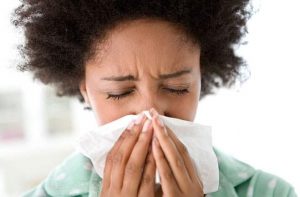Most everyone experiences allergy symptoms of some form or another, from common dust mites to animal dander to shellfish. While it’s unknown why, the African American population is more likely to have allergies, be diagnosed with more than one, and have more severe symptoms.
From a runny nose to a more life-threatening reaction, how do we develop an allergy, identify it, and treat it? How are allergies different for a Black person? Keep reading to learn more about allergies and what can be done about them.
Developing Allergies Through Sensitization
Allergic sensitization is the first step in developing an allergy. This allergy often begins before birth, as you are exposed to things your mother eats or is absorbed from various things within her environment. You become sensitized to other common allergens after birth, such as dust mites, foods, medications, and insect stings. When you start to develop symptoms of these allergens primarily depends on when you are first exposed to them and how often. The sensitization process begins when your immune system makes antibodies specific to the allergen you’ve encountered, known as immunoglobulin e (IgE). The previously created antibodies are triggered when exposed to that allergen again, causing symptoms.
For example, parents feeding their children solid foods for the first time may not realize they have developed an allergy. Parents should be mindful of reactions to new foods introduced to their diet. In another example, you may only start sneezing around a friend’s cat but have no symptoms around dogs. It’s possible to become sensitized to the pet dander of one type of pet and not another.
Most Common Allergens
While Black Americans are at higher risk for developing an allergy and having a more severe reaction to it (more about those statistics below), the most common types of allergies are similar among all ethnic groups.
- Seasonal: Sometimes called hay fever, these allergies worsen between March and September. The most common symptoms are sneezing, coughing, watery eyes, a runny nose, and a sinus headache. Seasonal allergy symptoms may also trigger an asthma attack.
- Mold: Damp environments may lead to mold growth indoors, especially in kitchens and bathrooms, but could be anywhere with poor ventilation. Not all molds are toxic, but many can trigger allergy symptoms like sneezing and watery eyes.
- Pet Dander: Like seasonal and mold allergies, animal dander can cause respiratory allergy symptoms. They are airborne allergens and can even contribute to dust mites and affect indoor air quality.
- Insect Stings: Stings and bites are the most likely to cause severe allergies. A life-threatening reaction called anaphylaxis requires immediate medical treatment. Symptoms of shock include a rash or hives, swelling of the face, and shortness of breath.
- Food: Foods can cause various allergic reactions, including itchy skin or hives, wheezing, vomiting, and swelling of the face. Determining what food allergies you have can be difficult. According to Food Allergy Research & Education, over 170 foods, like tree nuts and dairy, can cause uncomfortable and life-threatening symptoms.
- Medication: A side effect is not the same as a drug allergy. An allergic reaction to a medication can cause many symptoms, like hives, a rash, or a fever. More serious reactions could include anaphylaxis and require immediate intervention.
Identifying Skin Allergy Symptoms
It is often easier to identify an allergic reaction on pale skin. Itchy, red, swollen, and dry skin is much more visible. These more common signs, however, are not as notable on dark skin. If a skin reaction is the only symptom, it could go undiagnosed as an allergy for much longer, often until other symptoms arise. This is why both patients and their providers need to know how to recognize skin conditions caused by allergies.
- Hives: These are round- or oval-shaped raised bumps that typically occur in an isolated region or, in more severe cases, over a large area. They are itchy and become more uncomfortable if scratching or tight clothing irritates them.
- Angioedema: This can occur along with hives or on its own, usually causing severe swelling around the lips, cheeks, and eyes. The skin often feels warm to the touch and is more painful than itchy.
- Eczema: Some classic signs of eczema are the same on darker skin, like dry, ashy, and warm skin. You may experience sores. However, the redness typical of eczema on light skin usually appears purple or grey on Black people.
- Rash: A rash can appear as many things, from open sores to a slightly raised and itchy patch of skin. This is why it’s vital to communicate any symptoms you experience with your provider, any changes in your diet or medications, household location or pets, and other experiences.
Testing for Severe Allergies
If you or your medical provider feels you could have some form of allergy, you will likely be referred to an allergist. An allergist can use several types of testing to determine what foods, pollens, insects, or medications you are allergic to so you can avoid them.
The skin allergy test is the most common and has been the standard for decades. A small amount of the allergen is introduced to your skin with a tiny needle prick. An allergist will then wait for a reaction and measure any changes in your skin. A more accurate method is the allergy blood test, which measures the amount of immunoglobulin e present in your blood for the most common allergens. This blood test can measure the total amount of IgE in your system or test for specific allergens.
Because Black people typically have more than one allergy and reactions can be more severe, avoiding allergens is much more important. Testing for them can help prevent uncomfortable and sometimes life-threatening symptoms.
Allergy Treatment Options
Treatment options are similar for Black people because the immune system reacts similarly. However, the treatment doses may differ depending on your symptoms’ severity. You should consult your medical provider for guidance about which medications will work best for you and how to take them. Most respiratory symptoms can be treated with over-the-counter or commonly prescribed medications.
- Antihistamines: Over-the-counter antihistamines can help relieve allergy symptoms reasonably quickly and are available in various forms, including eye drops, pills, and nasal sprays.
- Corticosteroids: Corticosteroids are used as anti-inflammatories and are available in many forms to treat various allergy symptoms, including skin ointments, nasal sprays, and inhalers. They are often prescribed to treat flare-ups of chronic allergies.
- Decongestants: These medications can be used short-term to help relieve acute symptoms during a flare-up. Some people, like those with high blood pressure, should use caution when choosing decongestant medications and ask a medical provider before use.
- Allergy Shots: If avoiding allergens is not possible and the symptoms are difficult to control with the above treatment options, your medical provider may suggest allergy shots. These shots are designed to keep your body from overreacting to the allergen when you are exposed to it, but they aren’t effective for everyone.
Allergies and Black People
Studies have proven that there are many more Black people with allergic reactions to pollen, mold, insects, medications, and food than white people. Unfortunately, these studies have not determined why there is such a profound disparity between ethnic groups. Genetics don’t appear to be the root cause of the stark contrast in numbers, so further studies are necessary to understand why the Black population is at higher risk of allergic reactions, especially in severe cases requiring medical intervention.
At the American Academy of Allergy, Asthma & Immunology’s annual meeting in 2017, a team of doctors presented startling new data about the death rates in children with asthma. When carefully considering the demographics and other details of over 2,500 cases, it was clear that many children had much more severe cases of asthma because they didn’t have access to quality medical care. However, environmental pollution can trigger asthma, which often plagues low-income communities. Mostly African American neighborhoods may be near train stations, energy plants, and other places contributing to air pollution.
A study conducted at the Northwestern University Center for Food Allergy and Asthma Research found that nearly a quarter of all Black children had a shellfish allergy compared to just 3% of white children. These percentages only increased in children over five. The disparities were similar for wheat and soy allergies. Now, consider that food assistance programs rarely have options for those with food allergies, only assisting with certain foods or specific brands. Support from local food pantries may be even more limited, relying only on donations from local organizations and residents.
Other common allergens may also pose a more significant threat to Black people than the general population. Low-income housing may not be well-maintained, leading to mold. Multi-unit dwellings could make it difficult to manage bug infestations, causing insect stings and potentially severe allergic reactions. And those without adequate health insurance may have access to limited medications, some of which they are allergic to.
The Wrap-Up on Allergies
Whether it’s tree nuts or pollen, you don’t have to suffer from allergy symptoms just because of your racial identity. More studies are currently underway to determine why allergies disproportionately affect Black people. While it’s not clear whether it’s a family history or environmental factors, it’s clear that ethnic background can put you at higher risk for both symptoms and severity. If you are experiencing allergy symptoms, see a medical provider right away for guidance. They may refer you to an allergist who can test you for the most common allergens, helping you to avoid and adequately treat them.








